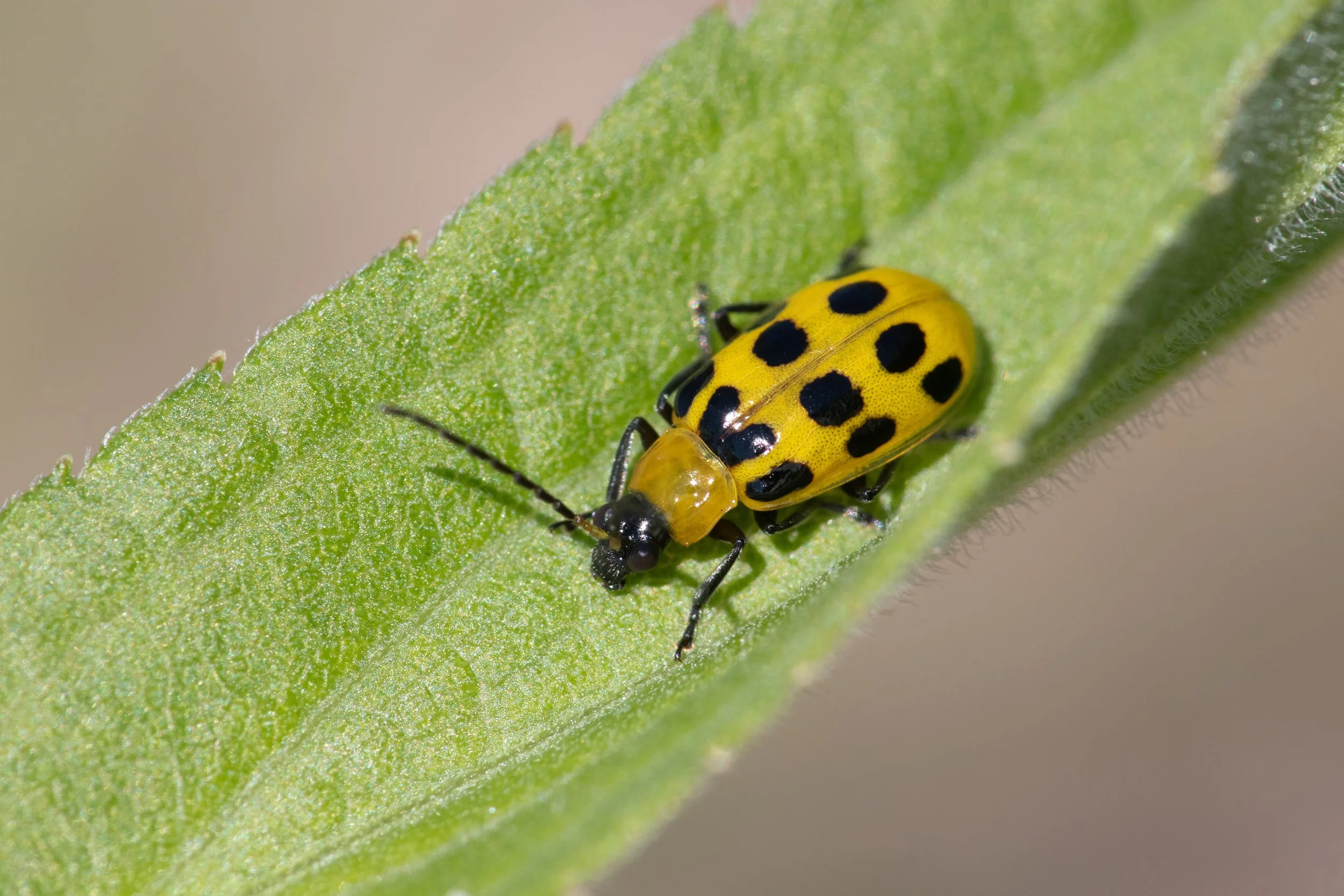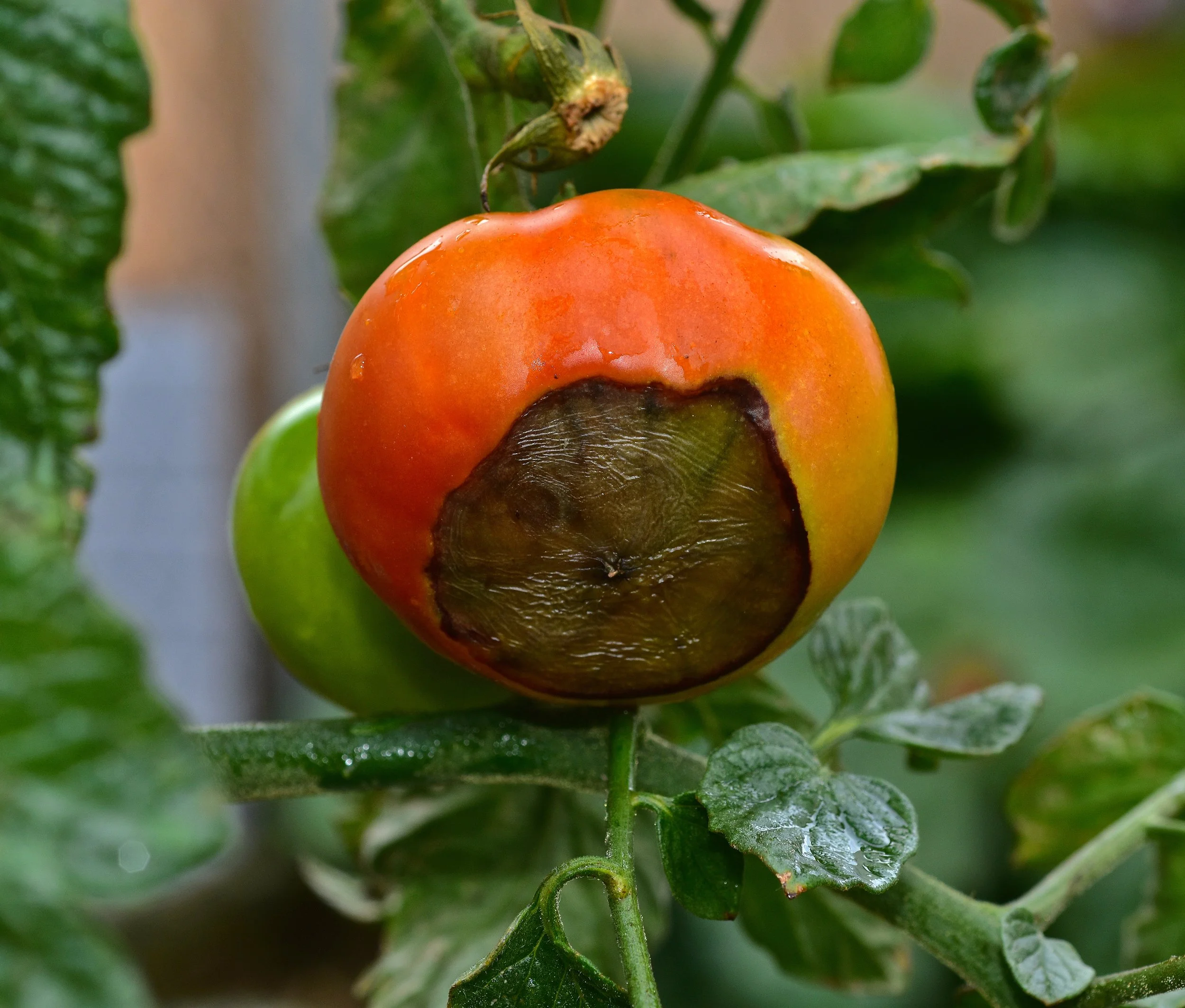Common Garden Pests & Diseases
Pests and diseases in the garden are pretty much inevitable. Here at Territorial, there are some common issues we see each year, so we will be posting a series of blogs to discuss best practice for handling these topics. This is not intended to be all-encompassing, and you may find another management practice that works better for you.
Cucumber Beetles
Despite their name, cucumber beetles feed on a wider variety of plants than just cucumbers. Cucumber beetles can be either spotted or striped, each with their own life cycles and host plants, but causing similar damage and being managed in the same way.
Identification
Striped: Striped cucumber beetles are yellow/green with three black stripes running lengthwise and black heads. They are elongated, approximately ¼” long. The larvae are slender, white grubs.
Spotted: Spotted cucumber beetles are also yellow/green with black heads but have 12 black spots on their backs rather than stripes. Adults are ¼” beetles, while larvae are ½” grubs with brown heads and brown patches on the first and last segments.
Life Cycle
Striped: Adult striped cucumber beetles overwinter in dense grass or under leaves, until they emerge in early spring to early summer. After emergence, they will feed on weed pollen for two weeks before they move on to crop plants, where they lay eggs at the base of the plant in the soil. There can be 1-3 generations per season depending on location.
Spotted: Adult spotted cucumber beetles overwinter in crop residues, emerging in the spring to lay eggs in soil close to plants. Eggs hatch in 2-3 weeks, and the newly hatched larvae feed on crowns and roots for 2-4 weeks before pupating. They emerge as adults later in the summer. Some beetles migrate north in mid-summer. Northern areas can see 1-2 generations/season, while southern areas can see 3.
Host Plants
Striped: Striped cucumber beetle larvae feed on the roots of cucurbits. Adults primarily feed on the above-ground parts of cucurbit plants but may also feed on corn, beans, peas, and the blossoms of other crops.
Spotted: Spotted cucumber beetle larvae, also called Southern corn rootworm, feed predominately on corn. As their name suggests, adults feed primarily on cucurbits, specifically squash but may be found munching on other vegetable crops and flowers.
Impact
Cucumber beetles can cause substantial damage in the garden. Larvae feeding on roots can cause serious stunting or death. Adult feeding on the leaves and shoots of seedlings can also cause death. Mature plants are typically able to survive feeding damage, although they may be less productive. Fruit may also be damaged. Even more important than the feeding damage and reduced productivity is the fact that cucumber beetles can spread bacterial wilt and cucumber mosaic virus, neither of which are curable.
Management and Control
As with most insects, garden cleanliness plays an important role in cucumber beetle management. Removing debris from the garden throughout the season, especially at the end, can help reduce harborage areas for adults.
The practice of trap cropping can aid in managing populations.
Utilize a physical barrier, such as a floating row cover, to help reduce damage, especially for younger plants. Physical barriers are most successful when used in conjunction with other management practices. Just make sure you remove the cover or hand pollinate while the plants are flowering.
Crop rotation has also been shown to help reduce cucumber beetle populations specifically when garden crops are rotated with cover crops.
You should begin monitoring your garden for cucumber beetles early in the season. Check your garden multiple times a week during peak cucumber beetle season – early spring through mid-summer – then weekly throughout the season. If you discover cucumber beetles in your garden, the best course of action is to remove them manually--either by hand or vacuum. A deep layer of straw mulch around the base of the plants can help reduce movement between plants and is especially effective on the striped cucumber beetle. As a last resort, applications of Neem or pyrethrins can help control cucumber beetle populations.
Blossom End Rot
I’m sure many of us have seen it – the dreaded brown, rotting end on our first tomato of the season. Blossom End Rot (BER) is an exceptionally common problem, although it is also a relatively easy fix, compared to many other garden issues.
Identification
Blossom End Rot is typically easy to identify. The blossom end of the fruit becomes dark brown or black, usually beginning on the first fruits of the season. BER may first appear as water-soaked spots before growing and darkening. Occasionally, the fruit may look okay from the outside but can be discolored when cut open. BER makes the fruit more susceptible to other pathogens, so tissue decay may occur if bacteria or fungi invade the affected fruit.
Cause
BER is typically due to a calcium deficiency in the soil. This deficiency occurs more frequently in hot, dry weather or when rapid growth takes place when excess nitrogen is available in the soil or other factors. Both issues cause the plant to draw extra water and nutrients to the leaves, starving the fruit of nutrients. Periods of excessive heavy rainfall can also cause available calcium to leach out of the root zone making it impossible for the plant to take up calcium; root damage can also reduce the amount of calcium the plant is able to take up. On the other hand, inconsistent irrigation may result in a decreased ability for the plant to absorb available calcium in the soil.
Host Plants
While tomatoes seem to be the most impacted crop, BER can also be experienced on other nightshades, specifically peppers, eggplant, and cucurbits.
Impact
BER is relatively easy to combat. When caught and controlled quickly, there is typically minimal impact other than the loss of a few fruits.
Management and Control
It is possible to avoid a problem with BER before it even starts. A soil test should be done to determine if there is enough available calcium in the soil, and if the soil pH is in the proper range (6.2-7.0). It is recommended to have your soil tested annually before you plant for the season and after any amendments have been added to the soil. If the result of your soil test shows lower than desired numbers, agricultural lime can be added to the soil to increase the amount of available calcium.
Ensure you use watering methods that allow for consistent and even watering. Utilize methods to maintain soil moisture, such as a thick layer of organic mulch.
You can also find ways to heat and maintain the soil temperature. Low tunnels, mulch, or plastic work well. Be sure to check the soil moisture regularly, and do not allow the soil to dry out or overheat.
Avoid over-fertilizing, especially with nitrogen.
When possible, plant resistant varieties or choose varieties that require less calcium.
Finally, use caution when cultivating to avoid root damage.
If you do experience BER, know that it doesn’t mean you did anything wrong – most gardeners will experience it at some point in their journey. Check your garden regularly once the fruit has started forming. Individual fruits will not recover once there are signs of BER, so remove any fruit with symptoms to avoid potential problems. This will allow the plant to focus on producing healthy fruit. Since BER is a nutrient deficiency rather than a disease, it won’t spread between plants, but rotting fruit can attract pests and make the plant more susceptible to disease.
Stay tuned for more! And as always, if you have any questions regarding these or other garden issues, our team is always ready and eager to offer support!
Author: Ashley W.





